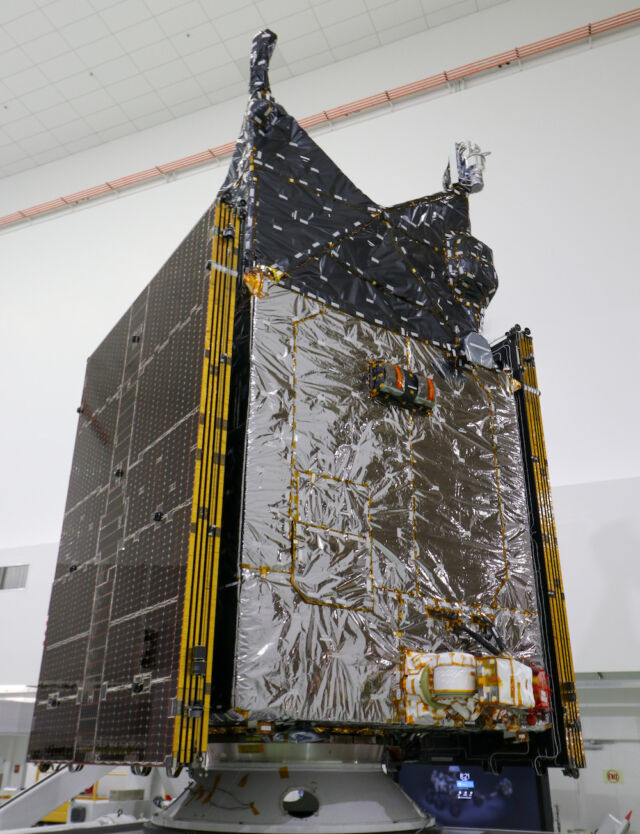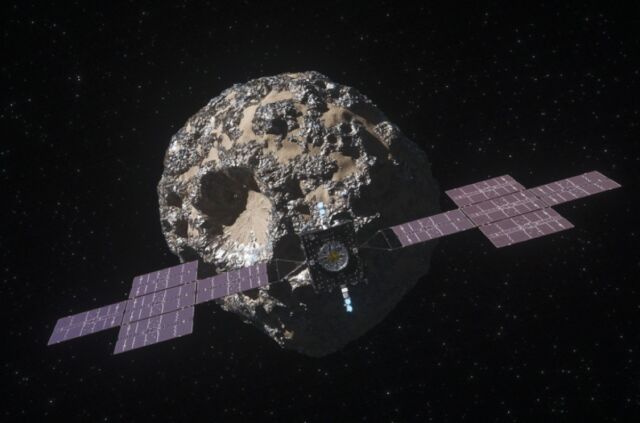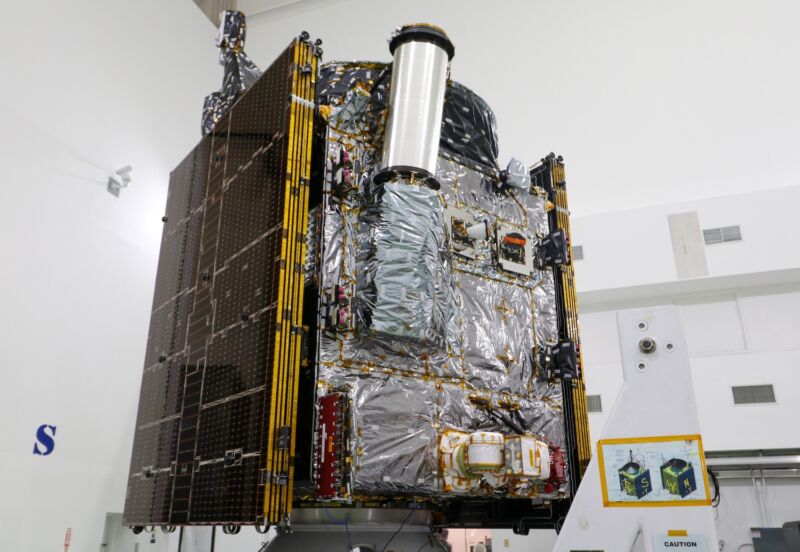"This is how the spacecraft will get mounted onto the interface to the Falcon Heavy.”
TITUSVILLE, Florida—NASA's Psyche spacecraft is running a year behind schedule before the beginning of its journey to explore a metal asteroid, but mission managers said Friday the probe is essentially ready for launch in less than two months.
The spacecraft is heading for asteroid Psyche, the mission's namesake, about three times farther from the Sun than Earth. Psyche is the largest metal-rich asteroid in the Solar System, with an average diameter of around 140 miles (226 kilometers). Observations from Earth indicate it's made mostly of nickel and iron.
The Psyche mission will be the first to explore a metal-rich asteroid, which may be the leftover core of a proto-planet that began forming in the early Solar System more than 4 billion years ago.
The spacecraft is ready for fueling inside a clean room near the launch site at the Kennedy Space Center in Florida. Two large solar arrays are folded up like an accordion against the central body of the spacecraft, and technicians have finished installing blankets of thermal insulation to shield the probe from the harsh cold of deep space.
In a few days, ground teams plan to start loading more than a metric ton of xenon gas into seven tanks inside the Psyche spacecraft, and cold nitrogen gas into three separate reservoirs. Those propellants will drive the Psyche spacecraft toward its destination in the asteroid belt between Mars and Jupiter.
The xenon will feed an electric propulsion system with four Hall effect thrusters, which will pulse almost continuously for Psyche's nearly six-year voyage to its asteroid target, where it will enter orbit in August 2029. The spacecraft will maneuver into several different orbits around Psyche, getting as close as 47 miles (75 kilometers) before its primary exploration phase ends in late 2031.
Next steps
In September, SpaceX will bring in the two payload fairing shells for its Falcon Heavy rocket. The Psyche spacecraft will be closed up inside, and if all goes according to plan, that's the last time the engineers and scientists who developed the mission will see their hardware with their own eyes.
Ars had a chance to see the Psyche spacecraft up close Friday with other news media representatives. The upshot: All's good for Psyche's launch on October 5.
“We are really buttoned up," said Henry Stone, Psyche's project manager at NASA's Jet Propulsion Laboratory. "This is how the spacecraft will get mounted onto the interface to the Falcon Heavy.”
“When you look at the body of this vehicle, it's about 8 feet across the bottom cube, and about 10 feet tall, not including the towers or booms, to which two of our science instruments are attached," Stone said. "One of the obvious features on the spacecraft is these very, very large solar arrays."

The Psyche spacecraft, less than two months from launch, is seen
inside its pre-launch processing facility in Florida on Friday.
Stephen Clark/Ars Technica
The solar arrays will unfurl and generate 20 kilowatts of power when Psyche is near Earth soon after launch. In the distant reaches of the asteroid belt, that will drop to 2 kilowatts.
All of the major components for SpaceX's Falcon Heavy rocket are undergoing launch preparations at the Kennedy Space Center or Cape Canaveral Space Force Station, according to Jim Hall, a senior mission manger for NASA's Launch Services Program, which brokers rides for NASA spacecraft on commercial rockets.
The Falcon Heavy's two reusable side boosters for the Psyche mission returned from their previous launch on July 28 with a commercial communications satellite. SpaceX is refurbishing those boosters—each with three flights on their record—for the Psyche launch. The side-mounted rockets will be recovered again at SpaceX's Cape Canaveral landing zones after the Psyche launch, and they'll be reused and expended on the launch of NASA's Europa Clipper mission in October 2024.
The center core of the Falcon Heavy rocket slated to launch Psyche is also in Florida for final launch preps, as are the two new aeroshells for the rocket's payload fairing. This will be the eighth flight of a Falcon Heavy rocket, but the first Falcon Heavy with a payload heading for another planetary body.
The liftoff of Psyche was delayed more than a year after a blend of workforce issues and software testing woes forced NASA to call off the mission's first launch opportunity. Those problems are now in the rear-view mirror, according to Lindy Elkins-Tanton, Psyche's principal investigator at Arizona State University.
But the delay cost NASA, and means the spacecraft will get to asteroid Psyche three years later than originally planned. Before the rescheduling of the launch to 2023, the Psyche mission was estimated to cost $985 million. That's now increased to $1.23 billion, according to a NASA spokesperson.
“This is primary exploration”
Scientists aren't sure what awaits the Psyche spacecraft when it reaches its destination. Elkins-Tanton said modeling of the asteroid's appearance based on telescopic observations suggests it has an irregular potato-like shape.
"It's not spherical," she said. "I always say potato-shaped because potatoes come in many shapes, so I'm not wrong."

Artist's illustration of NASA's Psyche spacecraft, as it will appear with its solar arrays unfurled in space.
NASA/JPL-Caltech/ASU
The hypothesis that Psyche may be the exposed metal core of a failed planet intrigues the mission's science team and got NASA's interest when the space agency approved the mission for full development in 2017.
"We’re never going to get to our metal core (inside Earth)," Elkins-Tanton said. "The pressures are too high. The temperatures are too hot. The technology is impossible. ... But there's one way in our Solar System that we can look at a metal core, and that is by going to this asteroid.
“We’ve visited bodies that are made of rock," Elkins-Tanton said. "We've visited icy asteroids. We've looked at comets and the last ... category of objects that we've never visited as a species in our Solar System is bodies made of metal. So this is primary exploration, a new kind of object that humans have never seen before."
Source



3175x175(CURRENT).thumb.jpg.b05acc060982b36f5891ba728e6d953c.jpg)


Recommended Comments
There are no comments to display.
Join the conversation
You can post now and register later. If you have an account, sign in now to post with your account.
Note: Your post will require moderator approval before it will be visible.